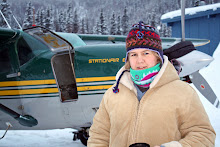The Kotzebue Report
 Stephen made it safely back from Kotzebue this afternoon. He was able to get on the earlier, direct flight from Kotzebue to Anchorage via standby. He said the landing was pretty rough (on his head, not as in turbulence). And he's pretty worn out. Tomorrow, he's going to try to see a doctor and get some meds to knock out what's ailing him.
Stephen made it safely back from Kotzebue this afternoon. He was able to get on the earlier, direct flight from Kotzebue to Anchorage via standby. He said the landing was pretty rough (on his head, not as in turbulence). And he's pretty worn out. Tomorrow, he's going to try to see a doctor and get some meds to knock out what's ailing him. He was wishing he'd taken a gun with him to Kotzebue. Apparently, he was in the midst of the major caribou migration while he was up there. They were mostly on the frozen waters of Kotzebue Sound, but there were lots of them! Maybe next year...
He was wishing he'd taken a gun with him to Kotzebue. Apparently, he was in the midst of the major caribou migration while he was up there. They were mostly on the frozen waters of Kotzebue Sound, but there were lots of them! Maybe next year... Kotzebue sits about 20 miles above the Arctic Circle on the tip of a slim peninsula jutting into Kotzebue Sound on the northwest coast of Alaska. (Check it out on Google Earth or Google Maps.) It's not as far north as Barrow, but it's up there! The sun rose at around 10:45am and set at around 6:30pm. Stephen took a photo of the setting sun.
Kotzebue sits about 20 miles above the Arctic Circle on the tip of a slim peninsula jutting into Kotzebue Sound on the northwest coast of Alaska. (Check it out on Google Earth or Google Maps.) It's not as far north as Barrow, but it's up there! The sun rose at around 10:45am and set at around 6:30pm. Stephen took a photo of the setting sun. He and one of his colleagues lodged at the local hotel, I believe the only hotel in Kotzebue. It is the orange 2-story building in the photo. The other sign on the building reads "Arctic Chiropractic".
He and one of his colleagues lodged at the local hotel, I believe the only hotel in Kotzebue. It is the orange 2-story building in the photo. The other sign on the building reads "Arctic Chiropractic".As you can see by the photos of the streets and buildings of Kotzebue, there is no point in trying to bury any powerlines. Permafrost.
I'm surprised by the number of cars and trucks there seem to be. Considering there's no place to drive to from there, just the streets within the village itself, there seem to be quite a few vehicles. Stephen says you can rent a car there for $145/day. Lots of folks use ATV's and snowmachines as well. This seems more logical.
As for other pricing, a gallon of milk was $9.95, a dozen eggs was $6.00. It was cheaper for people to fly to Anchorage, buy their groceries there in bulk (like twice a year) and mail it back to Kotzebue via the US Postal Service than to shop at the store in Kotzebue. Of course, for perishables like milk and eggs, there's little choice. The store in Kotzebue (as in almost all Alaska villages) is apparently owned and operated by Canadians. Hmmmm.
 Stephen took a photo of this poster which was on the wall in one of the buildings he was inspecting. It shows the Inupiaq Alphabet. Here is the text that's displayed on it:
Stephen took a photo of this poster which was on the wall in one of the buildings he was inspecting. It shows the Inupiaq Alphabet. Here is the text that's displayed on it:Thousands of years ago the Eskimo crossed the massive land bridge connecting the region now known as “Beringia.” Spreading eastward, Eskimos came to occupy an area stretching from Siberia to Greenland. Though relatively few in numbers, the indigenous home of the Eskimo groups now covers the largest geographical area of all of earth’s cultures.
In Alaska, the indigenous home of the Inupiaq people skirts Norton Sound, includes the Seward Peninsula, and arcs through the Northwest Arctic and the North Slope Boroughs.
Elders hold a special place in Inupiaq society. They are a source of wisdom, inspiration, and a living link to history and culture. Lessons are handed down from generations past through the story-telling of today’s elders. While it is rare today to hear a child speak fluent Inupiaq, elders have kept the Inupiaq language alive and interest in learning the language is growing. With guidance and support from elders the survival of culture and Inupiaq ways lives on.
Pretty interesting, huh?
Okay, well that's all for this episode. Tune in next time for another riveting adventure of "The Cold and The Dutiful".


1 Comments:
Dang one more car and they are gonna have to hang out the no vacancy sign. :o)
Rebecca
Post a Comment
<< Home